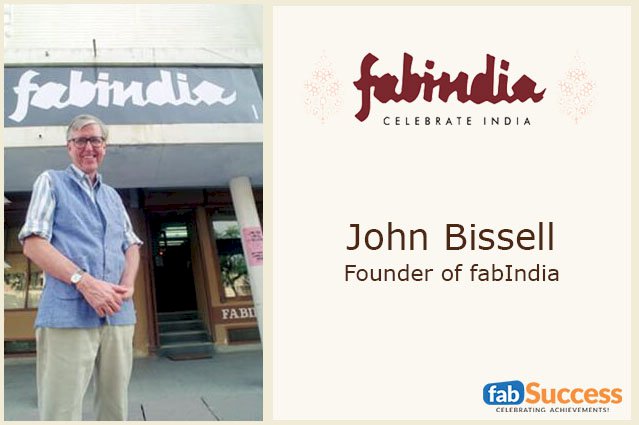Know The Real-Time Life Journey Of John Bissell To Become The Lengend Of FabIndia
A lesser-known name – John Bissell is the proud founder of Fabindia – a chain of retail stores selling garments, furnishings, fabrics, and ethnic products, which are handmade by craftspeople across rural India.
By Faber

With over Rs.1500 Crores valuation, along with 90,000+ artisans and craftspeople and roughly 200 stores across India and abroad, Fabindia today is widely known to be and has successfully managed to boost rural employment across villages in India. Due to such a unique business model, the craft-conscious enterprise concept of Fabindia has also become a Harvard Business School case study. On the completion of 50 years of the foundation of Fabindia, they have also released a book depicting the journey of Fabindia called – “The Fabric of Our Lives: The Story of Fabindia”, written by Radhika Singh. Today, apart from his wife Bimla Nanda, John is survived by a son and daughter, William and Monsoon.
A Journey to India!
Originally, John belonged to Hartford, where his grandfather served as the President of the Hartford Fire & Life Insurance Company. John completed his education at the Brooks School in North And over and then Yale.
Since his childhood, John grew up listening to the stories from his father about India during World War II. And thus grew his love for India as well.
After completing college, John began working for Macy’s, New York as a buyer, and at the same time also developed a sense of liking for the look and feel of hand-woven fabrics.
These two interest of his came to life when, in 1958, John was given a two-year grant from the Ford Foundation to guide and advise the Government of India run Central Cottage Industries Corporation in making goods for export.
He strongly believed that the Indian textile industry had immense potential to grow big and wanted to help Indian handloom textiles with a way to provide employment to traditional artisans.
During this phase, he met Bimla Nanda, who was serving the then United States Ambassadors to India – Chester A. Bowles and John Kenneth Galbraith, as their Social Secretary. After his grant expired, John decided to get married to Bimla and stay back in India. And hence began a new chapter in his life!
The Legend of Fabindia!
Now to provide the world with the beautiful crafts from India.
During his early years, John went on to travel across India, more specifically, craft-based villages and towns, to meet and find weavers and entrepreneurs, who could produce flatweaves, pale colors, and precise weights in handloom yardage. After searching for a long time, he finally narrowed down to his perfect match and got A. S. Khera, a dhurrie and home furnishing manufacturer in Panipat, as their supplier.
In 1964, John happened to meet the British designer Terence Conran, who had recently established a Home Furnishing Retail Company called Habitat.
One thing led to another and soon, Habitat became one of their biggest customers. While at it, John also went on to establish a distribution network in the United States, supplying their products to mom-and-pop stores.
And by 1965 the company was clocking a turnover of more than Rs. 20 lakhs, and had also moved from his house, into a proper office.
The difficulties & The Opportunities…
Now as time passed, a lot of transformations were brought about in the company as well. The company also had to go through an equal amount of problems, which they successfully managed to turn around into an opportunity to grow bigger.
During the peak of the Emergency Period enforced by the then Prime Minister Indira Gandhi in 1975-76, new rules were laid down by the govt. As per the guidelines, all the commercial establishments were strictly banned from running their business at residential properties, due to which Fabindia was forced to move out and from their second premises, a house on the Mathura Road. But this turned out to become a boon than a curse. John used this problem as an opportunity and opened their first Fabindia Retail store to sell their products in New Delhi, and also used it as their register office.
With this move, they had also begun catering to urban India as well, and to stand apart from other government-owned and subsidized players in the handloom fabrics and apparel sector; Fabindia decided to adapt their own fabrics and designs accordingly to the urban taste.
Visit Website
What's Your Reaction?



















